|
Spiritual Transmission as Grace:
|
|||||||||||||||
|
Chris Tong has been a devotee of Adi Da Samraj since 1989. He is one of the founders of this website. You can read his biographical information in the About Us section. This essay is an excerpt from Chris's forthcoming book, Beyond Everything. |
|
|
For seeing life is but a motion of limbs, the beginning whereof is in some principal part within; why may we not say, that all automata (engines that move themselves by springs and wheels as doth a watch) have an artificial life? For what is the heart, but a spring; and the nerves, but so many strings; and the joints, but so many wheels, giving motion to the whole body, such as was intended by the Artificer? Thomas Hobbes, Leviathan (1651) |
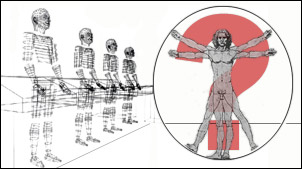 Are
we machines? If not altogether mechanical, to what degree
are we "machine", and to what degree, are we "free being", and
possessors of "free will"? To what degree are we in control of
our own destiny, and to what degree are we "predestined"?
Are
we machines? If not altogether mechanical, to what degree
are we "machine", and to what degree, are we "free being", and
possessors of "free will"? To what degree are we in control of
our own destiny, and to what degree are we "predestined"?
Certainly the signs of "man as machine" are everywhere. We see "man as machine" on the individual level in our habits, our addictions, our oedipal (and other egoic) patterns; much of our therapy is devoted to purchasing freedom from such past-regimented patterns. We see "man as machine" on the global level in centuries-old conflicts that are endlessly re-ignited by the automatic reactivity of "an eye for an eye". It would take a saint to be able to forgive the enemy who has just killed his family — foregoing the automatic impulse to vengeance, for the sake of a greater purpose.
Indeed, "it would take a saint" is the clue to an answer. Many traditions suggest that — as reflected by saints, sages, and other realizers — increasing spiritual maturity is what moves us along the spectrum from the "machine" end toward the "free being" end.
But how does one mature spiritually? To what degree can self-improvement result in spiritual maturity? Or is applying the metaphor of self-improvement to spiritual growth like trying to lift oneself up by the bootstraps? Is help necessary? What kind of help is required? The old maxim, "There but for the Grace of God go I", provides another clue: perhaps apart from circumstance, the only difference between myself and my less fortunate brother who is a murderer is Grace: help from the Greater Reality.
"A body in motion tends to stay in motion unless acted on by an outside force". We often learn Newton's first law of motion in the context of billiard balls on pool tables. But the same law is readily observed in "man as machine". I tend to react to men in the same, limited manner in which I tended to react to my own father. I will continue to do so until something awakens me to what I am doing, enables me to see alternatives, and assists me in establishing those alternatives as part of a new, less restrictive pattern.
But human beings are rather more complex than billiard balls; much is required to overcome the force of habit or the trend of history. Consider dieting as one example of attempting to overcome an addiction (or any other deep pattern) via self-improvement. The mind idealistically embraces the idea of losing weight, usually rallying itself around some new technique for doing that; but the body remains a distinct voice and force all the while. The mind may rule for a period; but, come that moment in front of the chocolate shop, when that delicious, sweet smell comes wafting out, and sensuously penetrates the nasal passages — instantly, the stomach starts growling, and the body politic initiates a coup d'etat, seizing the throne and commencing a food binge that may last days, weeks, or months. When the mind "comes to", it generally is perplexed about the failure of its program. It vastly underestimated (and never was actually in a position to overcome) the force and depth of the pattern it was attempting to address.
A more apt metaphor for "man as machine" than the passive billiard ball is "man as homeostatic system": a pattern of activity which, even when acted on by an outside force, will exert a counter-force, in order to perpetuate the present pattern. Thermostats are built to keep the house at a certain temperature homeostatically; a fall below that temperature turns the heater on, while a restoration to the status quo temperature turns the heater off. Just so, upon persisting at a certain weight for a sufficient length of time, the human body establishes that weight as a "set point" which it vigorously works to restore should body weight go lower (or higher).
On the basis of similar observations, thinkers as diverse as Montaigne, Pavlov, Gurdjieff, and Hubert Benoit, concluded that what is possible through self-improvement, or even improvement with the help of other human beings more or less like ourselves, is severely limited, because the ego is always re-setting and re-establishing itself.
Necessarily, the help we need for radical change or spiritual maturity, on the one hand must overwhelm our homeostatic system in the manner of a great "Outside Force"; and yet, on the other hand, it must also pull the rug out from beneath deep patterns in the manner of Something at an even greater depth (in accord with the principles of depth psychology). The "Grace of God" is a good name for Help which both overwhelms from without (via an All-Pervading Presence) and undermines from within (as the Prior Unity or Ground of Being, the Source of "within").
An interesting aspect of many contemporary addiction treatment programs (particularly twelve-step programs) are the steps in which the addict acknowledges the powerlessness of "man as machine" to relieve himself of his addiction, and accepts the need for Grace, or the intervention of a Higher Power, in his life. Just so, all the spiritual traditions of humankind are oriented around the need for Grace, and the establishment of a genuine connection with It, in order to grow not only humanly, but spiritually.
But once one intuits the need for Grace. . . Where to find It? How to link up with It? How to benefit from It?
In Western religious traditions, Grace often is viewed as a theological problem: we can readily identify those who got "It" in a big way — from Jesus, to Teresa of Avila, to Moses and Mohammed. We even have stories providing some details of how "It" came to them. But, so far as we know, only a rare few among us are genuine saints, sages, or Spiritual Masters. Up between the lines of these stories sneaks our suspicion that, not only are we not able to help or improve ourselves in any kind of truly radical way; but maybe even the choice of linking up with that which could make the difference is not in our hands either. Hence the thorny theological conundrums about predestination: if some are chosen by God to be recipients of Grace, are all the rest of us simply spiritually damned, with not a thing we can do about it (even though we spend a lifetime at spiritual practice)?
Curiously, the traditions of the East communicate an entirely different picture: Grace is readily available! Grace is abundant! In the East, Grace is not merely a synonym for "luck" or "good fortune". Grace is not only a relative rarity for the "predestined". Rather, Grace is a tangible Spiritual Transmission from the Greater Reality, accessible to anybody who is interested, and willing to live the kind of life that supports the steady reception of that Transmission. The living Spiritual Master (or Guru) is the means by which one contacts that Spiritual Transmission. (As my own Spiritual Master, Adi Da Samraj, put it, "The Guru is that process that we mean by the term 'Grace'.") Unlike miraculous visitations, which, by their nature, can only come and go in the wink of a mind's eye, the human Spiritual Master serves as a stable, persistent bridge between the material world and the Greater Reality, for the course of the Master's lifetime . . . and sometimes beyond — we'll get to that a little later in this article.
In the Eastern traditions, Grace is a veritable Ocean pouring down on one in the company of the Spiritual Transmission Master. In the Western traditions, what is in question is "God and His mysterious ways (in having only a short supply of Grace that is provided to only a select few)". In the Eastern traditions, this morphs into a question of personal responsibility: "An Ocean of Grace is available to me. But even if an Ocean of Grace pours upon me constantly, no transformation will occur if I hold up only a thimble in response. What kind of vessel am I going to be for that Ocean: a thimble, or a great cup?"
In studying this contrast between Western and Eastern traditions, one senses that the traditional Western religious view may be hampered by its lack of a recently living Spiritual Master who can provide a present-time demonstration of Spiritual Transmission. In sharp contrast, the Indian tradition holds that India has never experienced a time without either a living Spiritual Transmission Master or a saint capable of Spiritual Transmission. The Indian culture has always been one in which the view of the Spiritual Transmission Master as the source of Grace is common knowledge, grounded in somewhat less common experience. Those "in the know" are able to point newcomers to the Spiritual Transmission Masters alive in their time.
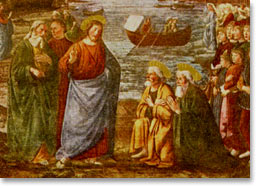 detail from "The Calling of the Disciples" Domenico Ghirlandaio (c. 1480) |
What does that less common experience look like? It certainly has the characteristic, necessary for transformation, of being an overwhelming "outside force". When Jesus of Nazareth approached Peter and Andrew and said simply, "Come, follow me", they dropped everything — work, family, possessions — to do just that. Granted, the story may have been recast in a simplified, mythic form, and its real, historical details may have included painful goodbyes, financial re-arrangements, and what not. But the essence of the response to Jesus' Spiritual Transmission is captured well by: "they straightaway left their nets and followed him." They were overwhelmed by his Transmission. Everything their lives had been about before seemed profoundly superficial in this revelation of a Greater Reality, communicated by the Grace of the Spiritual Transmission Master.
 Krishna and the Gopis detail from "Krishna Flutes Under a Tree" Rajasthan, Kishangarh, opaque watercolor and gold on paper (c. 1690) |
The Hindu tradition communicates a similar message through the story of Krishna and the gopi cowherd women. Upon hearing Krishna's flute, the gopis simply left their cattle to follow him. Like the disciples of Jesus, they dropped everything to follow their Spiritual Master because of something transmitted by his presence which completely overwhelmed them, and changed their sense of reality. Krishna's Spiritual Transmission (symbolized by his flute) made these women ecstatic.
 detail of sculpture, "The Ecstasy of St. Teresa of Avila" Giovanni Bernini (1652) |
While ecstasy per se is less emphasized in the stories of Jesus, the Christian mystical tradition in toto is filled with it. Bernini's statue of St. Teresa of Avila in Divine Communion is a beautiful rendering of her experience of ecstasy. Ecstasy as a result of Grace likewise is a common theme in the reports from the Sufi and Hassidic traditions.
 Gautama Buddha |
Spiritual Transmission appears in the stories surrounding Gautama the Buddha. On one occasion, the Buddha said no word, but simply held up a flower. Most of his disciples were puzzled. But Kasyapa smiled in response, "enlightened" on the spot; the Buddha acknowledged that Kasyapa had indeed received his Transmission. The point of the story is not the visible flower, but rather, the invisible Transmission passing from Gautama to Kasyapa, translating him (in that moment, or perhaps henceforth) into the "enlightened state". That Transmission is said to have initiated the Zen Buddhist tradition. The Zen teaching has been passed on from Master to disciple by direct Transmission ever since. The overt acts by which the Zen Master interacts with the disciple — even unconventional ones such as hitting the disciple over the head with a stick, throwing a rock at the disciple, and the like — can be more deeply understood in the manner of Gautama's flower. They are simply pointers or aids to the Spiritual Transmission that is occurring.
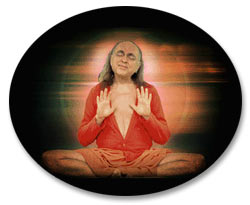 Avatar Adi Da Samraj |
Jesus, Krishna, and Gautama are no longer present "in the flesh". Nonetheless, tangible Spiritual Transmission continues as a living reality. When I found my Spiritual Master, Adi Da Samraj, I was a university professor, living one of the conventional lives of my time, even as the fishermen, Peter and Andrew, or the gopi women cowherds, had been doing in their time. But when I sat before my Master for the first time, His Transmission literally opened up my heart — waves of love for Him and for all beings came pouring from me spontaneously, in response to the enormous love I tangibly felt flowing from Him to me.
By taking up a way of life devoted to "tuning in" on that Transmission, my entire sense of reality gradually has been transformed. On such a Grace-full basis (rather than on the basis of self-conscious effort with my old sense of "material-only" reality still intact), over time, the force of all the varieties of machine-like patterning (emotional, mental, physical, psychic) that have placed limits on my happiness has gradually diminished, through their non-use.
Like the disciples of Jesus, or Krishna's gopi devotees, the secret of transformation in my case has been overwhelming distraction by the Grace of the Spiritual Transmission Master. As my Spiritual Master once humorously put it, while His devotee is "away", distracted by the ecstasy of His Transmission, the Master enters the devotee spiritually, and cleans up the place "like a little old lady cleaning out a bird cage." This cleansing, or release of old patterns, is not something the devotee does by effort; rather, the devotee allows the Master (who, unlike the devotee, is in a position to know what He or She is doing) to do the work.
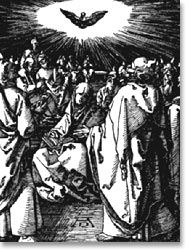 woodcut: "The Descent of the Holy Spirit" Albrecht Durer (c. 1510) |
In like manner, the stories of Jesus's disciples communicate a graceful transformation or "second birth" of weak, even cowardly men (the women devotees seemed less so), into extraordinary men "filled with the Spirit", able to endure incredible hardships (and even horrific deaths) through their reception of their Master's Spiritual Transmission (symbolized by the "Holy Spirit").
I have been writing from the viewpoint of Grace as a means for Spiritual growth and, ultimately, for Spiritual Liberation. But Grace is often sought for purely material help. Some of this is due simply to the influence of our currently materialistic culture, and a Western religious tradition that has placed more emphasis on the visible here and now, than on the "hereafter" (or, more accurately: the invisible "here and now"). But equally important is Abraham Maslow's hierarchy of needs: how can we invest any serious energy or attention on Spiritual Realization, when we are hungry, poor, sick, or at war? The "lower" needs must be handled, if not before the higher needs, then at the same time, in order for the spiritual practitioner to be freed from having to invest too much time, energy, and attention in caring for them.
Interestingly, the Grace of the Spiritual Transmission Master has always been understood to not only serve the Spiritual liberation of individuals, but also to have a beneficial effect on the world in ordinary terms. The Christian tradition of caring for the sick, clothing the poor, and feeding the hungry originated in the miraculous displays of Grace by Jesus: healings, feeding the multitudes, etc. That these too were the result of Spiritual Transmission is clear. For instance, in one incident, when a woman touches Jesus's robe and is healed, it is reported that "Jesus felt the power go out from him", indicating that a spontaneous Spiritual Transmission had caused her cure.
 Ramana Maharshi |
The twentieth-century Indian Master, Ramana Maharshi, often was asked, "Why don't you help the world?", apparently in response to the fact that he simply stayed in or near his room all the time. Maharshi's answer was, "How do you know I do not? A self-realized being cannot help benefitting the world. His very existence is the highest good." He thus reflected the questioner's limited understanding of Spiritual Transmission; the one who asked the question presumed that benefitting the world requires physical proximity and visible action.
Many traditions suggest that the material world is arising in a Greater-Than-Material Reality. Realize that Greater Reality (even only partially), and one will be able to help the material world from the greater vantage point of its Source (or at least closer to It). Asking a Spiritual Transmission Master why he or she is not out feeding the hungry is a little like asking the staff of a cancer research institute why they are not out treating the folks in their neighborhood for colds. Other doctors are already doing just that! The opportunity represented by the Spiritual Master and his or her Spiritual Transmission is rare.
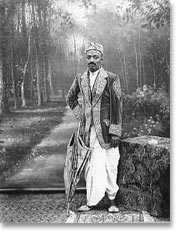 Narayan Maharaj |
The beneficial effect of Spiritual Transmission on the world can take many forms. The devotees of the Spiritual Master, Narayan Maharaj, believed his Spiritual Transmission was instrumental in the final resolution of World War II. The Master would read a detailed report every day on the war's progress. As the war continued, leaving large numbers of soldiers wounded and dying, mysterious wounds would appear on the Master's body, with no visible cause. As a result, he could neither walk nor eat. Finally, on September 3, 1945, Maharaj was told that the British had landed in Japan. He responded, "The war is over. My work is finished." He died later that same day.
But positive benefits on the material level are of limited spiritual value, because they pass, and because we die. Every one of the people that Jesus healed died later (even Lazarus). So obviously the eradication of death could not have been the point of these miracles. Thus Spiritual Masters have always sought to re-educate their disciples into valuing more greatly that which is eternal (or at least greater-than-material). For this reason, Masters warn disciples away from the fascinations of miraculous powers in and of themselves, because they only create temporary effects, and thus can represent a diversion from the true but narrow course leading to spiritual growth. To the extent that Spiritual Transmission leads to a more peaceful world and better life conditions, and thus, an environment more greatly conducive to Spiritual life, its use is truly spiritually valuable. But the seeking of Grace solely for the sake of material gain has always been criticized by the human sources of that Grace.
* * *
If the Spiritual Transmission Master is the means by which Grace enters tangibly and stably into the world, what happens to that source of Grace when the Spiritual Master dies? The answer depends completely upon the Realization of the Spiritual Master's disciples. A tradition remains Spiritually empowered because the Spiritual Realizer of one generation transmits his or her Realization to the disciple (or to an entire group of disciples), to the point where the disciple (or group of disciples) attains the same Realization, and is capable of serving as a vessel of Spiritual Transmission (from the original Spiritual Master, now no longer humanly incarnate) for the next generation. If the Realization "lessens" over the generations, the tradition can eventually reach a point where it continues to be socially viable but has become spiritually bankrupt; or it may splinter into genuine but small spiritual flames here and there.
The Christian mystical tradition is a representative example — in sheer numbers of acknowledged saints, the tradition reached its zenith between 1200 and 1700 AD; it has been diminishing ever since. The dwindling numbers coincide with a general sense that the Christian mystical tradition and many other such traditions are dwindling, particularly with the global spread of a strongly materialistic world view. Even the deeply spiritual culture of India has been strongly affected by its newfound lust for technology and material power, well-purposed toward eradicating the poverty and political powerlessness it has suffered for ages, but often at the cost of its spiritual heritage. India's surviving esoteric traditions are now mostly scattered pockets of spirituality.
In some sense, then, the greatest gift for the world that a Spiritual Transmission Master (past, present, or future) could leave — now or in the future — is the establishment of holy places, sacred teachings, and a community of truly practicing disciples, all of which together function to preserve and even magnify the Spiritual Master's Transmission down through the ages. In this context, we can read the symbol or metaphor of the Boddhisattva in terms larger than a single individual. A true Boddhisattva for this new millenium would be just such a living, Spiritually Transmitting culture and community, materially established on a global scale sufficient to counter the global sweep of materialism (through the direct Transmission of the greater-than-material Reality). Such a culture and community would communicate the existence and availability of Grace to the world at large; and it would persist in keeping Grace available in the world, until it fulfills the duty of all Boddhisattvas — that is, until the last "separate being" is Awakened out of the dream.
| Quotations
from and/or photographs of Avatar Adi Da Samraj used by permission of the copyright
owner: © Copyrighted materials used with the permission of The Avataric Samrajya of Adidam Pty Ltd, as trustee for The Avataric Samrajya of Adidam. All rights reserved. None of these materials may be disseminated or otherwise used for any non-personal purpose without the prior agreement of the copyright owner. ADIDAM is a trademark of The Avataric Samrajya of Adidam Pty Ltd, as Trustee for the Avataric Samrajya of Adidam. Technical problems with our site? Let our webmaster know. |
